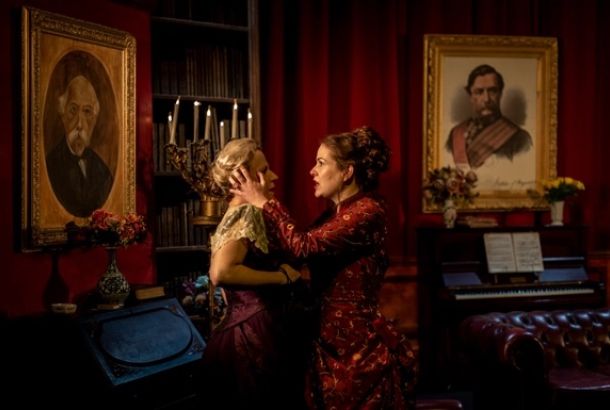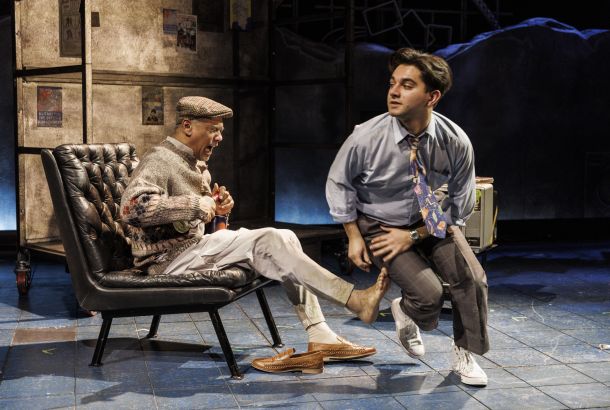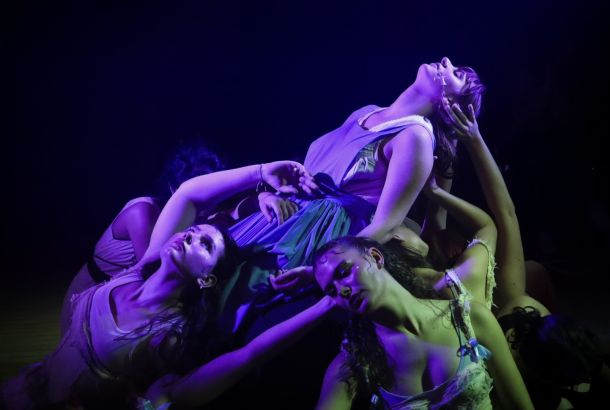Review: Shakespeare’s King Lear
As one of Shakespeare’s most notoriously difficult roles to play, there have not been many versions of high renown, resulting in steep pressure and intense comparison for any new production, in this case with the recent National Theatre version directed by Sam Mendes. Nevertheless, this juggernaut reading, celebrating Talawa’s 30th anniversary as well as 400 years since the death of the Bard himself, under the direction of Michael Buffong, managed to achieve a balance of independence and authenticity with seamless grace.
In the infamous title role was Don Warrington, whose portrayal of Lear certainly reached the high bar. Though his levels of rage plateaued at maximum decibel fairly early on, his transition into madness avoided the temptation of searching for a definitive turning point, instead slipping fluidly scene by scene. The subtlety of his tics was attentively approached, and hints of the former Lear were shown through the thick veil of insanity with masterful sensitivity. A favourite speech of mine, Act V Scene iii’s ‘Gilded Butterflies’ monologue was approached with a tenderness I have not before seen, and the death speech which followed was, pleasingly, not overworked, but happily appropriate to salute the character Warrington has so sensitively crafted. One of the few Lears to master not only the hard-hearted tyranny of the play’s opening, but also the rage of Act III’s storm, and the wounded nature of the man “more sinned against than sinning”, Warrington’s portrayal is nothing short of impressive.
Particular attention should be paid to Philip Whitchurch as the Earl of Gloucester, a role which is often overlooked, but is also incredibly difficult to play: A figure who fickly changes the object of his fatherly affection, Gloucester must command the sympathies of both his wronged son, and the weary audience. This was certainly achieved, playing the moment at which Gloucester loses his eyes not with writhing pain, as if often the case, but with the haunting stillness of losing our most valued of senses. This is certainly befitting of what the play teaches us; that no matter how harsh the character, we all experience pain and suffering in the same way.
Alfred Enoch’s Edgar must also be given due praise for a role which demands maturity and skill in its effective multi-rolling as Edgar’s Poor Tom and Beggar-man. As Poor Tom he drew attention without playing a caricature, although some of his lines were unfortunately swallowed. This aside, his treatment of physicality, as the demands on his character changed, was well thought-out.
The relationship between the three of Lear’s daughters was another strong point, the chemistry between them clear from the very first scene. However, it was a shame that the individual performances were lacking here. Debbie Korley’s Regan was unfortunately hugely underwhelming, underrepresenting a character whom I believe to be one of Shakespeare’s most insidiously evil; Pepter Lunkuse’s Cordelia was pleasingly youthful, but lacked the subtlety necessary for a role with such bold character yet such little stage-time, and appeared unfortunately overcooked in places. Rakie Ayola’s Goneril, however, provided the intensity and bitterness which is essential for Lear’s eldest daughter, whilst creating particularly palpable tension with Fraser Ayres’ malicious Edmund.
Amidst all this doom and gloom, Shakespeare does provide us with brief, occasional comic relief in the form of Oswald and the Fool, and these moments were well brought-out by Thomas Coombes and Miltos Yerolemou respectively, the former giving the audience a laugh a minute when on stage with his consistent, slimy portrayal.
The Royal Exchange is particularly well known for its costumes and sets, and this production was certainly no exception. In fact, I would argue that it was the work of the crew behind the scenes which gave the play such impact. The first thing you notice at the beginning of the performance is that the Royal Exchange’s traditional ‘in-the-round’ stage, as well as the floor of the auditorium, is covered with soil—an accurate metaphor for the grit and filth of ‘Nature’ around which the play revolves.
The stage itself was particularly interesting, a raised platform with a circle in the middle, which was itself tipped on an angle. This was particularly clever in Act I Scene i, during which Lear was sitting in his throne on the outer-ledge, in such a position that a step forward would be a step down, thus giving the very subtle but very effective illusion that his throne is above those looking towards him. However, this ledge, or similarly the resultant one opposite it, should surely have been used in Act IV Scene vi, where Gloucester attempts to commit suicide by jumping from a cliff, unaware that what lies in front of him is but a small mound.
What also caught my eye during the opening scene was the use of authentic flame torches, dotted around the outside of the stage and, more impressively, the use of stage lighting to accurately match the dull orange glow they gave off, giving the atmosphere of the play an intensity from the very beginning. For the most part, the lighting overcame the inevitable difficulties which arise from theatre in-the-round, save for a couple of unfortunate moments where Norman Bowman’s Cornwall was shrouded by shadow centre-stage.
Nevertheless, this was certainly compensated for by the inspired use of sound technology. If the spectator were to step outside the glass chamber which encases the auditorium, they would hear the dialogue from inside projected from speakers. A brilliantly simple way of keeping those off-stage on the same page as those on-stage. However, this was particularly effective in the way that, from inside the auditorium, the outside speakers could just about be heard, creating an acoustical effect reminiscent of an old church or hall. Immediately, therefore, what happens on stage takes on yet another layer of importance and gravity, giving Shakespeare’s story the air of myth or legend appropriate for the fables on which it is based. These off-stage speakers were also especially effective at times when entries from, for example, Lear and his entourage of a hundred knights, arrive on horseback with bugles sounding and horse-hooves pounding.
Often overlooked in these productions is the blocking of individual scenes, but praise must be given here to a particular moment which caught my attention during Act III. Here, the movement between the characters of Edgar, Lear and Gloucester ingeniously shielded Edgar from the eyes of Gloucester, the very man from whom Edgar was hiding, but the only man who would have recognised him.
However, what made Act III truly spectacular was the impressive technical feat of the storm sequence, which closed the first half. It is interesting to see how these scenes are approached from production to production, as often attempting real on-stage water can be a disaster. However, much like the 2008 Trevor Nunn filmed version, the use of water was truly effective, but here especially so as the water turned the soil into mud. What really created the illusion of the storm though was the combination of waterworks with the stunning lighting and sound. More than any other point in the first half, the audience was entirely encapsulated by the world that had been created. It was thus a real shame that the beginning of the second half, still set mid-storm, was rainless—perhaps technicalities had prevented this, but it was a shame nonetheless.
Another, similar inconsistency was the use of stage-blood. All was approached on the right foot at first, with Edmund’s (slightly underacted) self-harm, where the blood was certainly realistic. There was also, of course, the gut-wrenching eye-gouging of Gloucester, artfully done by Norman Bowman as Cornwall, which left a delightful chunk of eye on stage for the remainder of the play. However, the throat-slitting of Cornwall’s guard was definitely bloodless, and Edmund’s battle sequence was, in the context of previous choreographed sword-fights, somewhat embarrassing to watch, taking me back to the days of A-Level Drama monologues with invisible surroundings and props. I will stand by the opinion that if a production commits to something such as live blood, or even food and drink, then it must stick to it entirely so as not to invalidate its use in the first place.
These, however, are little things in the context of an exceptional production. Michael Buffong has painted the world of King Lear with vivid perception and stunning sensitivity, with the palette of an incredibly strong cast and beautifully detailed costumes, and with a canvas of astonishing set design and technology.
My Shakespeare teacher at school told me that everybody has their own definitive Lear: that will certainly be true of this production for many.
King Lear runs at the Royal Exchange Theatre from 1st April – 7th May, and at Birmingham Repertory Theatre from 19th – 28th May.







